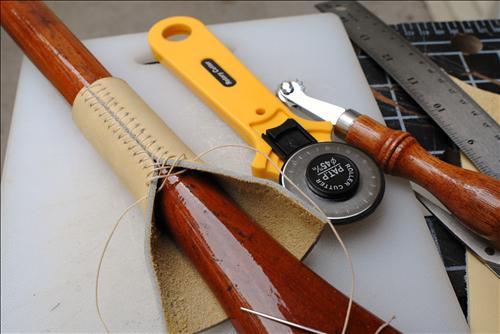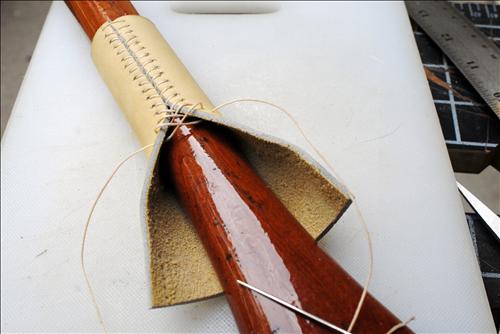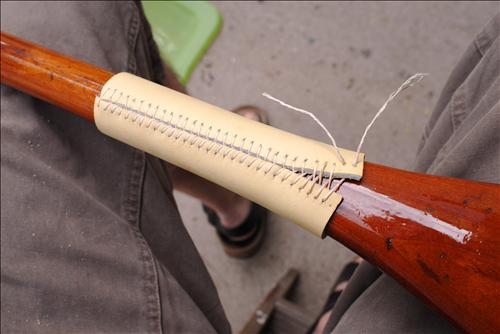Once the varnish is dry, it’s back to the rack for the paddles until they’re needed, except for a few of them. I wanted to add leather wraps to some of the paddle shafts where they often rub against the gunwales. It makes the paddles look cool and it does save a little wear and tear on my gunwales.
The leather for the wraps I got from a friend who know someone who know a guy who made the seat covers for the stools at Chipotle Grill. Since the stools are circles, that makes for a very inefficient use of leather, so I received a garbage bag of cut offs and pieces that, while too small for a stool, work great for a host of other things. Like wrapping paddle shafts.
The tools needed for this endeavor are quite simple. You need a cutting surface (I prefer old poly cutting boards as they are nice to my rotary cutter blades). You need a rotary cutter. You need a fid. You need an overstitch wheel. You need a spool of B200 Dacron, and two needles.
It’s pretty simple. Use the wheel to make marks on the leather, between 5 and 8 per inch (I prefer it finer and closer together), use the fid to punch holes in the leather, then cut a length of cord 5 to 6 times longer than your grip is, and get busy.
I like to use a baseball stitch. A true baseball stitch requires two needles working in parallel. You can’t really go down one side then go down the other…the tension will never be right. It’s also a little more fun to do it the right way because you can see your progress as you go, and adjust tension if needed.
Sure, I don’t use red thread, and there aren’t 108 stitches in my paddle wrap, but still, it’s the same stitch. If it can stand up to a juiced-up Mark McGwire it can stand up to a little gunwale rub.
The only really annoying thing that can happen is that you make a small error in calculation. For example, 5 to 6 lengths of your seam can cover the cord needed to stitch up the seam, no problem. Unless (this is a big unless) your holes are a little too far from the edge of the leather. This would mean you need more cord per stitch, and even if it’s a few millimeters, you add those millimeters up and pretty soon you’re 4 or 5 inches short.
I dodged a bullet here. I had barely an inch left on each side to tie off the seam. I really stinks to get three quarters of the way down a seam and get that little feeling in the area of your brain that does estimation…Uh oh…uh oh…what a bloody idiot I am…please, please be enough…
Well, I’ve learned over the past few years that it’s better to waste six or eight inches of cord than enjoy the feeling that comes with knowing you get to take apart your seam and start over again. It only takes an hour or less to do a wrap, start to finish, but it’s the principle of the thing.
Respectfully submitted,
Canoelover




